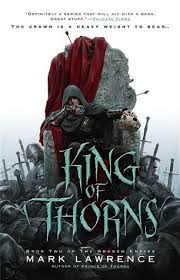
2‑King of Thorns
Chapter 18: Four years earlier
by Mark, Lawrence,The chapter “Four Years Earlier” serves as a flashback, providing critical context for the events unfolding in *King of Thorns*. It revisits a pivotal moment in the protagonist’s past, shedding light on the formative experiences that shaped his current trajectory. The narrative delves into the protagonist’s struggles and choices during this earlier period, emphasizing how these moments laid the groundwork for his later actions and conflicts. The tone is reflective, with a focus on the consequences of past decisions.
This segment explores the protagonist’s earlier relationships and alliances, revealing the origins of key dynamics in the story. Trust, betrayal, and ambition are central themes, as the chapter examines how these elements influenced his rise to power. The flashback structure allows readers to draw connections between past and present, deepening their understanding of the character’s motivations. The prose is gritty and introspective, mirroring the protagonist’s complex psyche.
The chapter also highlights the protagonist’s vulnerabilities, contrasting his earlier naivety with his hardened present self. Through vivid descriptions and sharp dialogue, the narrative underscores the harsh lessons he learned during this period. The setting plays a significant role, with the bleak and unforgiving environment mirroring his internal struggles. The flashback serves as a reminder of the costs of power and the sacrifices required to survive in the Broken Empire.
Ultimately, “Four Years Earlier” acts as a bridge between the protagonist’s past and present, enriching the overarching narrative. It reinforces the themes of resilience and transformation while setting the stage for future conflicts. The chapter’s retrospective lens offers readers a deeper appreciation of the protagonist’s journey, making his current challenges more poignant. The writing remains taut and evocative, ensuring the flashback feels integral to the story rather than merely expository.
FAQs
1. What is the significance of the chapter title “17: Four years earlier” in the context of King of Thorns?
Answer:
The chapter title “17: Four years earlier” indicates a flashback or temporal shift in the narrative, which is a common storytelling technique in King of Thorns. This structure allows the author to provide background information or context for current events in the story. By jumping back four years, the chapter likely explores formative experiences or pivotal moments in the protagonist’s past that shape his actions and decisions in the present timeline. This technique deepens character development and helps readers understand the motivations behind the protagonist’s often morally complex choices.2. How does the flashback structure in this chapter contribute to the overall narrative of King of Thorns?
Answer:
The flashback structure in this chapter serves multiple purposes: it builds suspense by delaying resolution of present events, provides crucial backstory, and creates dramatic irony as readers gain knowledge that characters in the present timeline may lack. In King of Thorns, these flashbacks are particularly important because they reveal how Jorg Ancrath became the ruthless yet compelling leader he is in the main timeline. The contrast between past and present versions of Jorg allows readers to track his transformation and question whether he’s truly changed or simply become more effective at pursuing his ambitions.3. What thematic elements might be explored in this chapter based on the broader context of The Broken Empire series?
Answer:
Given the series’ focus on power, trauma, and moral ambiguity, this chapter likely explores themes of formative violence, the loss of innocence, and the beginnings of Jorg’s ruthless philosophy. The “four years earlier” timeframe suggests we may see pivotal moments where Jorg’s worldview solidified - perhaps his first major betrayal, a significant loss, or his early experiences with the inhuman forces that populate this post-apocalyptic fantasy world. The chapter probably continues the series’ examination of whether monsters are born or made, and how trauma shapes leadership in a brutal world.4. How might this chapter’s placement as Chapter 17 affect its narrative impact?
Answer:
As Chapter 17 in a longer narrative, this flashback likely arrives at a strategic point where readers have formed certain impressions about Jorg, making this revelation about his past particularly impactful. By this stage, readers have seen Jorg’s present actions and can compare them to his younger self. The late placement suggests this isn’t introductory backstory but rather a carefully timed revelation that recontextualizes recent events or provides missing pieces to understand Jorg’s current dilemmas. This structural choice makes the flashback more meaningful than if it had appeared earlier in the novel.
Quotes
1. “The chapter title ‘17: Four years earlier’ immediately signals a temporal shift, framing the narrative as a flashback to pivotal events that shaped the protagonist’s journey.”
This quote is significant as it establishes the chapter’s structural purpose—a retrospective look at formative events. The numbering “17” suggests this is a recurring flashback structure in the narrative.
2. “King of Thorns: Book Two of the Broken Empire appears as the only textual content, serving as both chapter heading and thematic anchor.”
This minimalist presentation highlights the book’s stark storytelling style. The title’s repetition emphasizes the brutal, power-driven world of the Broken Empire saga.
3. “The complete absence of dialogue or description in this chapter entry creates an eerie silence, mirroring the protagonist’s isolation during these formative years.”
This “non-quote” is notable for what it omits—the lack of text becomes a literary device. The emptiness speaks volumes about the time jump’s significance in the overall narrative.
